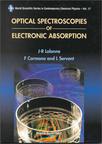电子吸收的光谱学
出版时间:1999-12 出版社:东南大学出版社 作者:Lalanne, J. R.; Servant, L.; Carmona, F. 页数:325
内容概要
This book, a companion volume to Electronic Structure and Chemical Bonding (World Scientific, 1996), is concerned with the teaching of optical spectroscopies of electronic absorption. It is the culmination of about ten years of experience in the teaching of the subject and the training of students to become teachers in the physical sciences. The book covers topics of current research and includes about 30 problems with solutions, most of which are adapted from tests proposed recently at the "Aggregation" in chemistry and physics. It provides as much coverage of elementary quantum mechanics, group theory and the electronic structure of molecules as is necessary for the reader to understand the rest of the topics. Also included are numerous appendices, often presented as charts to facilitate assimilation, as well as short bibliographies, limited to basic books and review articles. This volume will be an invaluable guide for teachers and potential teachers in the physical sciences, and more generally for students and engineers in chemical physics and physics.
书籍目录
PrefaceAcknowledgmentsSymbolsPART I Theoretical FrameChapter I.- IntroductionChapter II. - Classical Theory of Light II. 1. Introduction: The different representations of light II.2. Classical theory of light II.2.1. Electromagnetism and Maxwell's equations II.2.1.1. Maxwell's equations II.2.1.2. The wave equation II.2.2. Three solutions for Maxwell's equations II.2.2.1. The spherical wave II.2.2.2. The plane wave II.2.2.3. Gaussian wave II.3. Exercises and problems II. 3.1. Electromagnetic wave propagation in vacuum II.3.2. Search for a particular Gaussian solution of the wave equation II.3.3. Treatment of Gaussian wm,es with lenses II.4. Appendices II.4.1. Table of electromagnetic waves II. 4.2. Various forms of the Maxwell's equations ]1.4.3. Three particular solutions to the wave equation II.5. BibliographyChapter HI- Matter and its properties III. 1. Non relativistic quantum mechanics III.1.1. Fundamental principles and brief history III. 1.1.1. Probabilistic description III. 1.1.2. The problem of measurement and operators III.1.2. Principles of the non relativistic quantum theory III.l.2.1. Postulates concerning the description of the system III. 1.2.2. Principles for the measurement of physical quantities III. 1.2.3. Evolution principle III.1.2.4. Correspondence principle III.1.2.5. Spin creation principle III. 1.2.6. Antisymmetrization principle III.2. Symmetry and group theory III. 2.1. Symmetry elements and svmmsetry operations III.2.2. Representation of an operation by an operator III.2.3. Group structure and classification III.2.4. Group representation III.2.4.1. Introduction to the notion of representation III.2.4.2. Representation properties III.2.4.3. Direct product of two representations III.3. Application of quantum mechanics and group theory to the description of stationary electronic states in atoms and molecules III.3.1. Description of the electronic structure of the hydrogen atom and of the hydrogenic atoms III. 3.1.1. Solution of tile eigenvalue equation for tile Hamiltonian operator IlI.3.1.2, Energy and shell model III.3.1.3. State vector and atomic orbital multiplicity III.3.1.4. Various representations of probability densities in real space III.3.1.5. Spin orbit coupling III.3.2. The description of the electronic structure of many-electron atoms III.3.2.1. Central field approximation III.3.2.2. Electrostatic and magnetic interactions: Russel-Saunders and spin-orbit couplings III.3.2.3. Description of configurations III.3.3.Description of electronic structure of molecules III.3.3.1. General presentation Ill.3.3.2. Methods for solving the electronic eigenvalue equation III.3.4. Vibrational and rotational structure of electronic levels in atoms and molecules IlI.3.4.1. Vibrational structure III.3.4.2. Rotational structure III.3.4.3. Vibration-rotation interaction III.3.5. Conclusions and consequences about electronic levels IlI.4. Exercises et problems III.4.1. Questions about symmetry: true or false? III.4.2. General aspects of LCAO theory III.4.3. Study of the orbitals of 1, 3 butadiene III.4.4. Energy ofsinglet and triplet states of a two-electron system III.5. Appendices III.5.1. Main properties of linear transformations and matrices III.5.2. Representation of an operator by a matrix III.5.3. Tables of the postulates of quantum theory III.5. 4. Tables of characters of the symmetry groups used in this book III.6. Bibliography……PART II Optical Spectroscopies of Electronec AbsorptionINDEX
图书封面
评论、评分、阅读与下载
